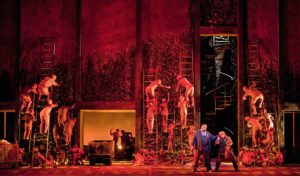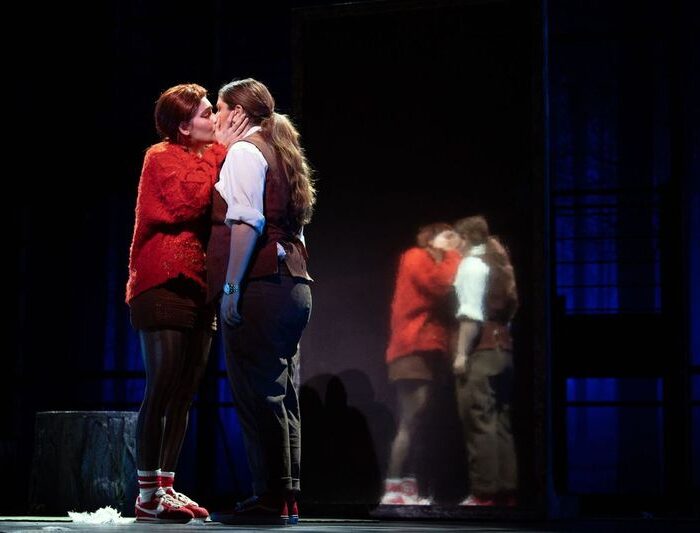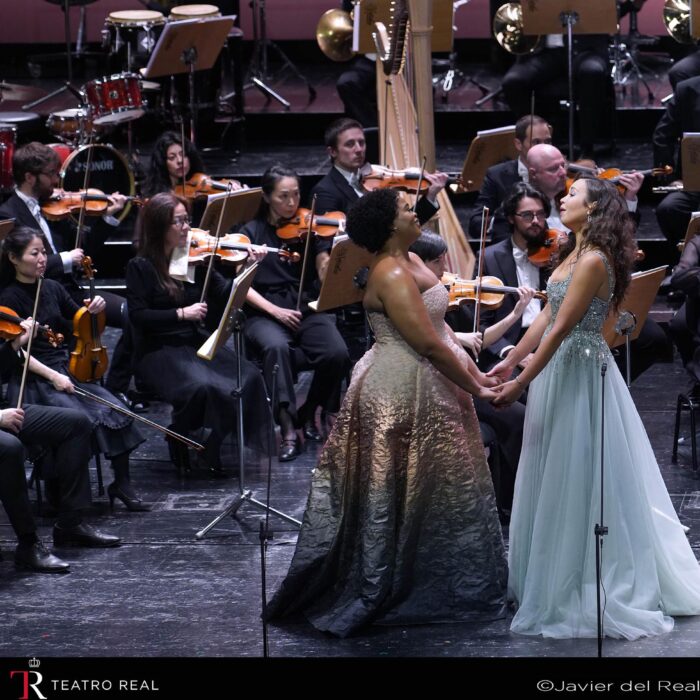
San Francisco Opera Virtual Review 2021: Das Rheingold
Zambello’s 2018 Production is a Vocal & Visual Marvel to Behold
By Lois Silverstein(Credit: Cory Weaver)
Some people might be looking for a hero in these days of pandemic, especially locked down at home. Throughout the month of March, San Francisco Opera (SFO) is offering one such hero: the Virtual Ring Festival.
You read that right: a “hero” in the form of a quest. It is the quest to retrieve a stolen golden ring and restore order in the universe right from the comfort of your own living room, complete with gods and goddesses, giants, dwarfs, Norns, Rhinemaidens and Valkyries. If there was ever a time to hunker down and immerse yourself in a good quest, and especially one that explores the fight for human redemption, this is it. Welcome to Wagner’s “Ring.”
A co-production with Washington National Opera, San Francisco has been streaming its 2018 “Ring” on weekends in March. The operas are bookended by ancillary talks, interviews, and discussions on aspects of its creation, production, and musical and dramaturgical experiences, by opera singers, directors, musicians, dramaturgs and writers, including Tony Kushner, Alex Ross, Kip Cranna, Jane Eaglen, Iréne Theorin, among many others. In so many ways, this is an excellent opportunity to steep these long days in the heroics, music, and human journey that is the “Ring” saga.
While “Ring” is virtual viewing, it is a living testimony to art itself and the human endeavor to lead ourselves through art and beyond the constricting desires of power and control. To trace this trajectory now, on the heels of this long year of suffering, is a brilliant stroke: Wagner would have doubtless advocated it. Through listening to the talks, interviews, and discussions, as well as plunging into the four operas themselves, hopefully, we can begin to move beyond lockdown and begin to experience life with new energy.
The First Stop
“Das Rheingold”—the first opera in the sequence of four that makes up the “Ring” cycle—streamed over the weekend, both on Saturday the 6th and Sunday the 7th. The production by Francesca Zambello was conducted by Sir Donald Runnicles and starred Greer Grimsley as Wotan, Jamie Barton as Fricka, Falk Struckmanm as Alberich, Stefan Margita as Loge, Andrea Silvestrelli as Fasolt, Raymond Aceto as Fafner, Ronnita Miller as Erda, David Cangelosi as Mime, Julie Adams as Freia, Brian Mulligan as Donner, and Brandon Jovanovich as Froh. The Rhinemaidens were performed by Renee Tatum, Stacey Tappan, and Lauren McNeese. In all a sparkling cast!
With set design by Michael Yeargan, projections by Jan Hartley and S. Katy Tucker, associate direction and choreography by Denni Sayers, costumes by Catherine Zuber and lighting by Mark McCullogh, SFO presents what Zambello calls an “American Ring.” The Rhine is set within the natural landscape of California, where Rhinemaidens gambol in the vibrant waters. As the saga continues lust, greed and power threaten the natural world and the abandonment of love finally destroys it. Over the four-opera cycle, the natural world decays into technological domination. Will it be redeemed through sacrifice? Will love be reborn through suicide?
While spears remain in the production, this is a landscape free of horns and helmets. The naturalistic effects are offset by the marvel of lighting, projections, and special effects that lift us beyond conventional time and space. Alberich sings “I am everywhere, even when you can’t see me,” bringing the two worlds together. The performance is stunning.
What Wagner could only dream of in his original production in 1876 we are rich with from the beginning of Scene One: projections of sumptuous clouds and billowing water in variegated colors, smoke and mists galore, and continuous movement, appearing and disappearing creatures, sea maidens frolicking in the waves in old-fashioned female frivolity. Accompanying these giggling girls, the fulsome strings, harps and winds accent the flowing world in which they live and to which we enter.
The Rhinemaidens’ voices are at once loquacious as well as instrumental, their teasing and taunting of Alberich—the lusty and aggressive dwarf whose covetous actions will catalyze the events of the entire saga—are of one cloth, contributing to the blurry and watery skies and depths where we inevitably lose our moorings. As the melodies shift and change, we not only lose our boundaries, but we willingly give them up. “Oh, yes, take us with you!” we cry as the tempting song and frivolous games proceed. “Let us follow wherever it is you lead, even if it differs from what we know and believe.”
Scene Two seems to bring us back to earth. The setting is a familiar, 19th century domestic scene, complete with lounge chairs and the architectural plans for a castle: in other words, we are in Valhalla. A group of characters are gathered, some human, some demi-gods. We have Fricka, wife of Wotan; Freia, sister of Fricka and soon-to-be kidnap victim; and Wotan, husband and man in charge, plus a couple of brothers-in-law, Donner and Froh.
As they navigate their own personal chicaneries a couple of giants appear: Fafner and Fasolt, accoutered like a pair of construction workers. Entertaining imagery, but apt as well, for they are the builders of Valhalla and they are come to collect their payment. It is then that we not only lose our moorings by an order of magnitude but the domestic charade takes on a more malevolent wise. The giants want Freia, who is not only sister of Fricka but the goddess of youth, whose golden apples keep everyone young. The golden apples on the stage—a basket of them which look both real and delectable—also carry mythic connotations. We have moved into another level of understanding and exploration, that of the mythic and the miraculous. What we are dealing with includes avarice, power, conflict, love, conjugal harmony, and the elemental realms of heaven as well as a story both human and trans-human.
The interchange among the elements in this production is as smooth as it is dynamic. Some of that is prepared for in Wagner’s own musical and aesthetic composition. In this scene, Loge is the Trickster and is played as a roguish demigod. He moves nimbly from human to divine and back again, singing and cavorting with an intentional wink.
Zambello’s production moves smoothly between her human, American scenes and the watery, demiurgic realm of gods, allowing us to make sense of the admixture of realities with increasing ease even as the music leads and excites us.
Musical Heroics
Runnicles guides the orchestra with grace and grandeur. He varies the colors of the score in a palette we could not circumscribe even if we wanted to. The matching of the depths of sound with the depths of feeling and the exploration of ideas of space and time are silky and magical. We move dexterously from the realm of myth and fairy tale to philosophy and daily life. Runnicles brings the orchestra to striking emotional depths as the characters paint their conflicts in sound: music describes rage and lust, fear and yearning.
This is like the very forge, Nibelheim, that creates the gold of the ring which launches the saga. This itself is a magnificent, Dantean underworld scene. At the moment Wotan and Loge catch Alberich, the stage glitters and rumbles with the near-visible sounds of the orchestra. We feel that we are there even though we are listening and watching through a set of screens. Is this something more than virtual reality?
At no time is Runnicles’ mastery dwarfed by what’s unfolding on stage. The 89-piece orchestra lifts and guides the volume and the abundant liquidity. From rippling strings, along with two harps, the brilliant brass establishes a fine sheen and lends backbone to the declamations onstage. Runnicles underscores and leads the stage narrative, both informing and guiding it. As stirring and stimulating as the production is, the music goes even farther. It is a pearl.
Fricka, sung by American mezzo Jaime Barton, is not only beautifully sung but extremely well-acted. Every facial expression, every pout, grimace, plea, and moment of righteous indignation, stands out when she is onstage. Totally present in every scene, she could easily be performing a George Bernard Shaw play, with all the wit and pointedness of a speaking actress. She excellently mingles with Wotan, played by American bass-baritone Greer Grimsley, who is well-known for his widely performed Wotan. They not only portray the ups and downs of a married couple but convince us that they are truly the pair. They get as close as possible to a real down-to-earth couple as we have in Wagner, even though they are only part human. That is one of the bonuses of this Runnicles/Zambello production: we can identify with their apparent ordinariness while we are stretched into the realm of the extraordinary and so embrace the discussions of slavery and freedom without problem. We take in topics discussing our greed, vanity and surrender with an equally open mind. When they sing in dialogue, we sometimes forget they are actually singing with exceptional athleticism and beauty and not just chatting over tea. At moments they bring us friendly reminders of the domesticity of Juno and Jupiter as portrayed in Shakespeare’s “The Winter’s Tale.”
Grimsley’s Wotan is easy to relate to. His resonant voice can be intimate as well as portentous. He is a man in charge and he is a man who craves more power. He seems to understand this and he threatens with tremendous ego. Dashing on stage in his ascot and high boots, jodhpurs and smart jacket, he sings so easily it is as if he is hardly singing at all. So too does he portray his humanity as something that lacks full understanding, but which Wotan can still learn. When Erda, played and sung with stunning depth by Ronnita Miller, warns him to forfeit the ring and escape the curse, we feel him actively considering what to do. Grimsley never swerves in “Das Rheingold” from the human and so never loses his favor with the audience. We are willing to follow him through his own violence and cravenness as he seeks a moral compass within his own desires.
Falk Struckmann plays an admirable Alberich: active, mobile and adroit in both movement and emotional maneuvering. He reaches a high point when he is captured by Wotan and Loge, his physicality and his vocal agility coupling to create a lively captive. Alberich cringes under his chains. He protests such treatment and issues his famous curse. “Am I free? Really free?” Alberich sings with plangent tone. “I curse the ring. No one will rejoice in its gleam.” So, the master and slave theme sounds loud and clear. Immediately after, we experience a wide projection of mountains and sky, indicating the two realms’ correspondence. We are moved from the depths of anger to the wider extension of the universe.
Stefan Margita’s Loge is a demi-god whose wit and canniness both move the plot along and demonstrates the range of human chicanery. His voice occasionally seems more subdued than his humorous physical dexterity on stage but he never loses his wiliness and skill to make things happen as he wants.
Brian Mulligan’s Donner, exhibits beautiful lyricism in the final scene. The giants Fasolt and Fafner lumber across the stage on their stilts and down-to-earth overalls with skill and focus, their leitmotifs drumming as they display their gauche demands, their bass voices accompanying their gait and their purpose. Albeit circus-like, their importance to the plot and to the depths of human demands is never sacrificed. Cangelosi’s Mime seems vocally light-white but entices us to look forward to his mentorship of Siegfried in opera number three.
What we find in this production is a fine integration of folk/primitive elements which accrues deeper meaning as the plot unfolds through music, text, and characterization towards the opera’s resolution. We are, by the end, as at home with a rainbow bridge climbing into the sky to Valhalla as if it is a cruise ship that is about to set sail into the element. We are perhaps as integrated as the characters with their ancestral lineages to the inevitable narration that is yet to unfold in the ensuing operas. Wagner wrote the music to “Das Rheingold” last of the four operas, even though it is the “Vorspiel”‘ Still, it synthesizes mythic and human elements that seem to have come first in creation and inspiration. Runnicles and Zambello and their brilliant production team lead us through sweeping skies, billowing waters and misty fogs right into other dimensions to explore.



